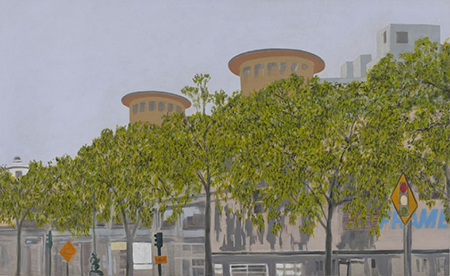
Continuing through July 15, 2017
The thirty-two minute film of Robert Smithson’s "Spiral Jetty" serves as an introduction for the group exhibition “Vernacular Environments, Part 1.” The early earthwork, engineered in 1970, became the foundational post-studio piece from which some of the most ambitious projects of our time were inspired. Located on the shore of the Great Salt Lake in Utah, and the film captures the artist's process, documentation, and joyful engagement. The narrow gallery corridor in which it’s viewed serves as the only entrance into the larger exhibition space. Once we step through the black curtain, we are met with a range of media exploring how artists engage with architecture and the built environment, something "Spiral Jetty" accomplished with honors.
A series of three 2016 photographs by Richard Barnes capture aspects of a performance by Alex Schweder and Ward Shelley as they live within “ReActor” house, a rectangular modern home that rotates and shifts on a concrete column, depending upon where the artists are standing and which way the wind is blowing. A much more stoic piece is the tombstone-like sculpture "UN Speaker" (2002) by Jennifer Bolande. The freestanding piece is enclosed in a concrete frame that stretches speaker fabric on one-side, while the opposite displays a print of the United Nations building in Manhattan. The geometric patterns of windows and speaker fabric juxtapose the amplification of global politics that happen within in the skyscraper. The heaviness of these interactions are in contrast to the drawings of Raúl Cordero, whose tropical scenes, each image partially obstructed by text, deconstruct the landscape. "Tropical Drawing No. 3,” for example, reads, “It was too rare and lasted too short, but she found true love that week in the badlands." From "Spiral Jetty" to the present day, artists continue to push the way we interact with our environment. "Vernacular Environments, Part 1" offers a number of aesthetically provocative perspectives that encourage us to reflect this inquiry well after we exit the same way we entered.
